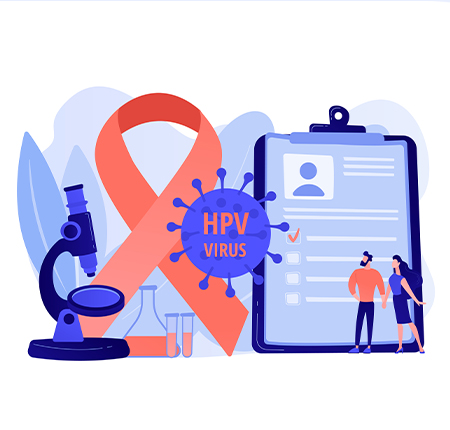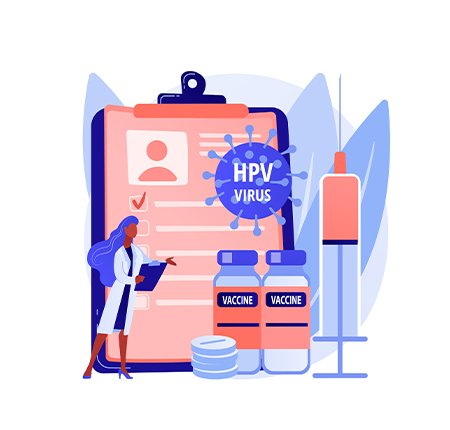
Human Papilloma Virus (HPV) is such a common viral infection that most sexually active people experience it at some point. But what exactly is HPV? What are the causes and how can it be prevented? Read our article to find out everything you wanted to know!
What is HPV (Human Papilloma Virus)?
According to the Centers for Disease Control and Prevention (CDC), HPV is the most common sexually transmitted infection: almost all sexually active people, regardless of gender, will have an HPV infection at least once in their lifetime.

There are more than 100 known types of HPV, of which more than 40 are sexually transmitted. HPV is usually harmless and goes away on its own. However, some types of infection can lead to genital warts and even cancer.
HPV infection - Symptoms. How do you know you have an HPV infection?

Most people who contract the virus have no symptoms. The infection can go away on its own without any health problems, especially when the immune system fights the virus. But if HPV remains in the body, it can be contagious and the infection can be passed on. So it is important to remove the virus when you know of its presence. Here are some symptoms:
Genital venereal growths (condylomata). There are lesions, swellings or protrusions like stems; appear at the level of the vulva, near the anus, cervix or vagina; they don't cause discomfort or pain, but they can be itchy.
Common warts. There are hard bumps on the hands and fingers; they can cause pain, injury and bleeding.
Plantar warts. They are usually hard and appear on the heels and soles, causing discomfort.
Filiform or flat warts. They look like lesions and can be anywhere on the body. In women, they appear most frequently on the legs.
If you notice any of these signs, it is essential to schedule a medical consultation.
Types of HPV
So, what exactly are the types of HPV ?
Most genital HPV infections are not dangerous and go away on their own. Two types of HPV (types 6 and 11) cause most cases of warts that are considered low-risk because they do not lead to cancer or other serious health problems.
Instead, there are 16 high-risk strains, of which 2 (18 and 16) are responsible for 70% of cervical cancers. Furthermore, studies show that approximately 99% of cervical cancer cases are due to HPV infection.
Causes and risk factors

HPV infection occurs when the virus enters the body, most often through sexual contact. But there are risk factors that you should be aware of:
Number of sexual partners: Although not a rule, a large number of sexual partners can increase the risk of an HPV infection. But regardless of the number of partners, if you are sexually active (with only one partner) the risk already exists.
Age: Simple warts appear most often in children, and genital warts, especially in teenagers and young adults.
Immune system: when it is weakened or you are taking treatment that affects it, after a transplant or if you have an HIV infection.
Skin lesions: scratches, lesions, wounds on the surface of the skin that may be more exposed to HPV infection
Direct contact with other people's lesions/warts, touching surfaces that have been in contact with HPV - for example, in public showers or swimming pools.
How is the HPV virus transmitted?
HPV affects the mouth, throat or genital area. So sexual contact is not the only way HPV is transmitted. In fact, the virus can be transferred through a cut, an abrasion of the skin, or simply through skin-to-skin contact.
What's more, a person with HPV can pass the infection on to someone even if they don't have symptoms. You can contract HPV by:
any skin-to-skin contact of the genital area
vaginal, anal or oral sex
sex toy exchange
Symptoms can appear years after contact with the virus, which complicates things when you want to find out the exact cause and when you came into contact with the virus.
HPV virus in women
In most cases, women have no symptoms. But sometimes, lesions can be observed inside the vagina or at the level of the vulva or anus. A gynecological consultation is essential if you notice such lesions, and the simplest way to prevent complications is regular gynecological check-ups.
HPV virus in men
Most cases do not show symptoms, like women, but sometimes warts can appear on the genitals. Some strains can lead to cancer (at the level of the penis, anus or throat) and the low immune system favors the appearance of infections.
The types of HPV that men can get are the same as women.
The HPV virus in pregnancy
If you contract the virus during pregnancy, you may develop symptoms on the cervix. That's why routine screening for cervical cancer is recommended: it can be done even if you're pregnant, and doctors recommend starting treatment only after giving birth.
In some cases, HPV infection can lead to complications in pregnancy or childbirth, and in rare cases, the virus can be passed on to the baby.
Manifestations of HPV infection
Recent studies estimate that 14 million people become infected with HPV annually. Moreover, there are various manifestations of the infection: some types of HPV cause lesions inside the vagina or cervix and which are only discovered through screening exams. In other cases, warts appear. But let's take them one at a time!
Condylomata - Genital venereal growths
Condylomata or warts are growths on the surface of the vulva or near the anus and in men they can appear on the penis, scrotum or around the anus. They are painless, but can cause itching.
warts
Warts can be of three types: common, plantar and flat.
Common warts: small skin growths with a rough, irregular surface that can multiply. They most often appear on the fingers and hands in general, and can appear near the nail or under the nail. Warts can be painful to the touch.
Plantar warts or plantar warts: grow on the soles of the feet, especially on the heels. They are usually painful.
Flat warts: These can develop on the face, arms, hands or feet. They usually have a smooth appearance and can be harder to spot because of this. In women, they appear most frequently on the legs.
The difference between HPV and HIV
HPV infection is not the only one transmitted through sexual contact. HIV can be transmitted in the same way, but there is no medical connection between the two. So you should not confuse HIV with HPV. HIV is the human immunodeficiency virus, and it is an RNA virus, unlike HPV, which is a DNA virus.
Moreover, HIV is mainly transmitted through blood or fluids following sexual contact, while HPV is transmitted through the skin, mainly from abrasive surfaces or sexual contact.
HPV diagnosis
How can you tell if you have an HPV infection? There are several diagnostic methods:
A physical exam and appropriate investigations
The Babeș-Papanicolau test
colonoscopy
The HPV test
Cervical biopsy
Physical examination
A doctor can diagnose you when he notices lesions on the skin or mucous membranes through a simple physical exam. Moreover, he can also recommend other investigations, for example a Babeș-Papanicolau test.
The Babeș-Papanicolau test
The gynecologist collects a sample of secretion from the cervix for a Pap test, a method of detecting changes when there are no visible warts or other physical symptoms.
colposcopy
The gynecologist can also perform this test, which consists in examining the cervix with the help of a solution that makes it possible to observe HPV-infected cells.
The HPV test
The HPV genotyping test is done when there are no visible symptoms, by analyzing a secretion sample. It is similar to the Babeș-Pap test, so the gynecologist can perform both tests at the same time. With the help of the test, the DNA of high-risk strains can be detected.
Cervical biopsy
Depending on the results of the usual HPV tests and analyses, your gynecologist may recommend additional examinations. One of these is the cervical biopsy, to determine precancerous or cancerous cells in the cervix.
HPV treatment
HPV infection can go away without treatment, simply with the help of your immune system. If, however, the symptoms cause you discomfort or bother you from an aesthetic point of view, the warts can be removed.

How do you get rid of HPV warts?
Warts can be removed at the patient's initiative or if they contain precancerous cells. And there are some methods and procedures. First, there are topical medications that you can apply to the lesions to treat them. But these drugs can have side effects and lead to irritation. Other methods to remove warts would be:
Laser therapy
Electrosurgical excision
Cryotherapy
Electrocautery
Complications of HPV
Not all types of HPV lead to complications or cancer, but lesions caused by high-risk HPV strains can turn into cancer over time.
Cervical cancer, for example, is the most common type of cancer and is associated with HPV infection. Unfortunately, complications have no symptoms except in advanced forms of the disease, which makes them difficult to treat. It is all the more important to maintain regular gynecological check-ups and Pap tests.
Cervical and vaginal cancer
Cervical cancer caused by HPV infection is the third most common cancer worldwide among women. In Romania, it is the second most common type of cancer, after breast cancer, and the average age for its appearance is 50 years. However, age is not a rule and it can appear at any time, including much earlier.
How is the diagnosis made? Cervical biopsy is necessary, a clinical examination and endoscopic and imaging investigations: therefore, by X-ray, CT, MRI, cytoscopy and other specialized examinations.
But it is not the only type of cancer caused by the virus. Another type of cancer is vaginal cancer. It occurs more frequently in people over 60, and the most common symptoms are abnormal bleeding.
Analyzes and advice for the prevention of the HPV virus
Fortunately, you can substantially reduce the risks of HPV infection, but it all starts with open dialogue between you and your doctor and awareness of these risk factors. What can you do to prevent an infection?

Use a condom when you have sex. Although it does not cover the entire genital area, it is an effective way to prevent HPV transmission
If you notice warts in your or your partner's genital area, avoid sexual contact until they are removed or treated
Respect basic hygiene measures, such as washing hands, not sharing personal items
Protect and strengthen your immune system through nutrition
Test yourself periodically and regularly with the Babeș-Papanicolau test
"Cervical cancer is a leading cause of death among women. In 2020, approximately 604,000 women were diagnosed with cervical cancer worldwide and approximately 342,000 women died from the disease. ” ( source )
HPV vaccine
Fortunately, there are safe protection solutions, and the HPV vaccine, for both girls and boys, is considered the best way to protect against the types of cancer caused by HPV.

How long does the HPV vaccine protect?
HPV vaccination, when given before adolescence, can give you long-term protection without the need for a booster. But the studies are still in development, and the duration is analyzed depending on the type of vaccine. Protection can last, for example, up to 10 years for Gardasil, 9 for Cervarix and at least 6 years for Gardasil 9.
But you should know that it doesn't work as well as you get older, and especially if you've already had an HPV infection.
How many types of HPV vaccine are there?
Currently, there are 3 types of HPV vaccine that are recommended for both girls and women as well as boys and men from age 9 until age 26.
The types of vaccine are Gardasil, Gardasil 9 and Cervarix:
All prevent infection with HPV strains 16 and 18
Gardasil also prevents infection with HPV strains 6 and 11 (these are the causes of 90% of vaginal warts)
Gardasil 9 also prevents infection against the above strains but also against 5 carcinogenic HPV types (31, 33, 45, 52 and 58)
Until what age is the HPV vaccine given?
Although it is recommended that it be done as soon as possible, there is also a variant of the vaccine for people up to 45 years who have never been vaccinated against HPV, which consists of three doses given in 6 months. However, HPV vaccination is not recommended for all adults in this age group, so it is essential to talk to your doctor if you are between 26 and 45 years old.
Effectiveness of the HPV vaccine
Recent studies show that the HPV vaccine has reduced infection by 70% within 1-4 years of vaccination and by 83% within 5-8 years of vaccination.
HPV vaccine side effects
Like any other vaccine, the HPV vaccine can have side effects. We are talking about mild reactions: fever, nausea, headache and dizziness, and the site of vaccine administration may be painful. However, some people can have severe allergic reactions, so it's good to check with your doctor what kind of contraindications you might have, depending on your allergies.
How safe are HPV vaccines?
Over the past 12 years, research and monitoring of HPV vaccines around the world has shown that the vaccines are effective and safe: more than 120 million doses of the HPV vaccine have been administered.
HPV vaccine contraindications
As for contraindications, there are 2 major ones:
If you are pregnant, you will need to postpone vaccination until after your pregnancy. However, if you have already been vaccinated, this is not a reason to terminate the pregnancy.
If you have severe allergic reactions to any ingredient in the vaccine, including yeast or latex.
The HPV vaccine and the National Vaccination Program
In Romania, anti-HPV vaccination is included in the National Vaccination Program as early as 2020. What does this mean?
The anti-HPV vaccination is free and is done with the Gardasil 9 vaccine if you are between 11-14 years old. If you are over 15 years old and have not yet been vaccinated against HPV, you can benefit from the vaccine for free. Talk to your doctor, and if you need more information, write to us!






















